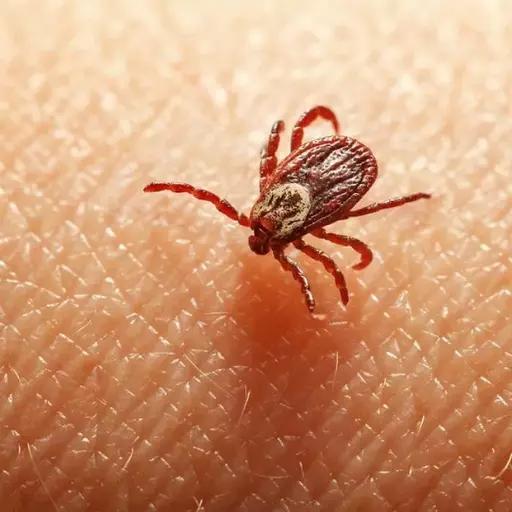Warning of Dangerous SFTS Infectious Disease for Pets and Their Owners
Health authorities have warned that the risk of contracting a deadly infectious disease through pets is increasing.
This disease is Severe Fever with Thrombocytopenia Syndrome (SFTS), which is transmitted by the Haemaphysalis longicornis tick. Dogs or cats can become infected after being bitten by a tick in grassy areas and may then transmit the infection to humans, or the ticks that the dog brings home can bite humans, leading to infection.

The Korea Disease Control and Prevention Agency has been monitoring SFTS infections in pets in collaboration with the Animal and Plant Quarantine Agency and the Korean Veterinary Medical Association since April of last year. The results show that over 8 months, 58 dogs and one cat were infected.
Out of 40 dogs whose treatment progress was confirmed, 5 unfortunately died. Only 167 out of over 4,000 animal hospitals nationwide participated in this monitoring, leading to estimates that actual infections could be much higher.
SFTS is a representative high-risk zoonotic infectious disease that can affect both animals and humans. Animals can transmit the disease to humans, and it can rarely spread from person to person.
On June 22 of last year, a staff member at an animal hospital (23 years old) became infected after being bitten by a dog infected with SFTS. Even though they wore protective gloves, it was of no use.
A week later, they experienced high fever over 38 degrees Celsius and diarrhea, and they received a confirmed diagnosis on July 4 of last year. Fortunately, treatment for the symptoms was effective, and they were discharged after a week.

When dogs contract SFTS, they show symptoms such as a runny nose, lethargy, and poor appetite. If a person rubs their eyes or nose with hands that have touched the bodily fluids (like tears, nasal discharge, or blood) of an infected dog, they can become infected. It is said that infected dogs and cats generally recover well with treatment at an animal hospital.
Humans infected with SFTS can also transmit it to others. The disease does not spread through respiratory means but can be contracted through direct or indirect contact with the patient's blood, saliva, and other fluids.
Since SFTS was designated as a legal infectious disease in 2013, 30 cases of secondary infection have been reported until last year. Among these, 27 were healthcare workers, 2 were family members of patients, and 1 was a funeral director. In 2020, there was a cluster infection involving 15 healthcare workers performing CPR on a severely infected patient who died.
However, the number of people infected by being bitten by ticks is much higher than those infected through pets. Last year, 163 people contracted the disease while engaging in outdoor activities, with peak occurrences from April to November.

On the 15th of this month, an 80-year-old woman in Namwon, Jeollabuk-do, was infected after being bitten by a tick while working in the fields. This was the first reported case of the year. The internationally known fatality rate ranges from 12% to 47%, which is very high.
Key symptoms include fever, diarrhea, muscle pain, chills, and headaches. There are no preventive vaccines or treatments available. Symptomatic treatment, including the use of antipyretics, is provided.
For this reason, the World Health Organization (WHO) has designated SFTS as a global priority disease.
The Disease Control Agency is concerned that the risk of infection through pets is not being adequately managed. Kim Jong-hee, director of the Zoonotic Infectious Disease Management Division, stated, "The Haemaphysalis longicornis tick that carries the SFTS virus is present not only in the mountains and fields but also in grassy areas around apartments in large cities." He emphasized the importance of avoiding grassy areas when walking dogs.
When engaging in outdoor activities, it is crucial to wear long-sleeved shirts and long pants, and to wear hats, sleeves, and socks. Clothing should not be left on the grass or laid down upon, and one should refrain from defecating on grassy areas. It is recommended to wash clothes worn during outdoor activities.

There are a total of 13 zoonotic infectious diseases, the most dangerous of which is avian influenza (AI).
Experts, including those from the Disease Control Agency, consider it a candidate for the next pandemic. AI has recently spread to cattle in the U.S. and sheep in the UK, and reports of mass deaths among cats have emerged in South Korea.
As AI mutations intensify, experts stress the need for vigilance, noting that it is crossing species barriers to infect genetically similar animals such as cattle and cats.
Q fever remains a concern as well. It is a zoonotic infectious disease transmitted to humans from cattle and goats through droplets.
Gastrointestinal infections caused by Campylobacter and Salmonella originate from chickens, and experts advise caution when consuming undercooked chicken or raw eggs.
Image Source: Reference photos for understanding the article / gettyimagesbank


